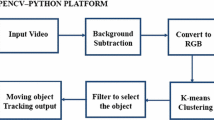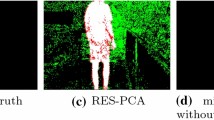Abstract
Background subtraction, binary morphology, and connected components analysis are the first processing steps in many vision-based tracking applications. Although background subtraction has been the subject of much research, it is typically treated as a stand-alone process, dissociated from the subsequent phases of object recognition and tracking. This paper presents a method for decreasing computational cost in visual tracking systems by using track state estimates to direct and constrain image segmentation via background subtraction and connected components analysis. We also present a multiple target tracking application that uses the technique to achieve a large reduction in computation costs.
Similar content being viewed by others
References
Atkeson, C.G., Moore, A.W., Schaal, S.: Locally weighted learning. Artif. Intell. Rev. 11(1–5), 11–73 (1997). http://citeseer.ist.psu.edu/atkeson96locally.html
Bar-Shalom Y. and Fortmann T. (1987). Tracking and data association. Academic, San Diego
Cheung S.C. and Kamath C. (2004). Robust techniques for background subtraction in urban traffic video. In: Panchanathan, S. and Vasudev, B. (eds) Proceedings of Electronic Imaging: Visual Communications and Image Processing 2004 (Part 1), vol. 5308, pp 881–892. SPIE, San Jose
Collins J. and Uhlmann J. (1992). Efficient gating in data association with multivariate gaussian distributed states. IEEE Trans Aero Elec. Syst. 28(3): 909–916
Cucchiara R., Grana C., Piccardi M. and Prati A. (2003). Detecting moving objects, ghosts, and shadows in video streams. IEEE Trans. Pattern Anal. Mach. Intell. 25(10): 1337–1342
De Walther, U., Rutishauser, C.K., Perona, P.: On the usefulness of attention for object recognition. In: 2nd International Workshop on Attention and Performance in Computational Vision at ECCV04 (2004)
Fuentes, L., Velastin, S.: People tracking in surveillance applications. In: PETS 2001. Hawaii, Hamilton (2001)
Haritaoglu, I., Harwood, D., Davis, L.S.: W4S: A real-time system detecting and tracking people in 2 1/2d. In: ECCV (1), pp. 877–892 (1998)
Harville, M.: A framework for high-level feedback to adaptive, per-pixel, mixture-of-gaussian background models. In: ECCV’02: Proceedings of the 7th European Conference on Computer Vision-Part III, pp. 543–560. Springer, London (2002)
Itti L. and Koch C. (2001). Computational modeling of visual attention. Nat. Rev. Neurosci. 2(3): 194–203
Kiril, A., Konstantinova, P.: Hypotheses pruning in jpda algorithm for multiple target tracking in clutter. In: International Conference Automatic and Informatics, pp. 45–48 (2003)
Li, Y., Dore, A., Orwell, J.: Evaluating the performance of systems for tracking football players and ball. In: AVSS05, pp. 632–637 (2005)
Lipton, A., Fujiyoshi, H., Patil, R.: Moving target classification and tracking from real-time video. In: Proceedings of the 1998 DARPA Image Understanding Workshop (IUW’98) (1998)
Magee, D.: Tracking multiple vehicles using foreground, background and motion models. In: Proceedings of ECCV Workshop on Statistical Methods in Video Processing, pp. 7–12 (2002)
Nillius, P., Sullivan, J., Carlsson, S.: Multi-target tracking - linking identities using bayesian network inference. In: CVPR 2006, pp. 2187–2194 (2006)
Oh, S., Sastry, S.: A polynomial-time approximation algorithm for joint probabilistic data association. In: Proceedings American Control Conference (2005)
Oliva, A., Torralba, A.B., Castelhano, M.S., Henderson, J.M.: Top-down control of visual attention in object detection. In: ICIP (1), pp. 253–256 (2003)
Oliver, N.M., Rosario, B., Pentland, A.: A Bayesian computer vision system for modeling human interactions. IEEE Trans. Pattern Anal. Mach. Intell. 22(8), 831–843 (2000). http://citeseer.ist.psu.edu/oliver99bayesian.html
Orwell, J., Remagnino, P., Jones, G.: From connected components to object sequences. In: First IEEE International Workshop on Performance Evaluation of Tracking and Surveillance, pp. 72–79. Grenoble, France (2000)
Parkhurst D., Law K. and Niebur E. (2002). Modeling the role of salience in the allocation of overt visual attention. Vis. Res. 42(1): 107–123
Rosales, R., Sclaroff, S.: Improved Tracking of Multiple Humans with Trajectory Predcition and Occlusion Modeling. Tech. Rep. BUCS-TR-1998-007, CS Department, Boston University (1998). http://www.cs.bu.edu/techreports/1998-007-tracking-multiple-humans.ps.Z
Stark L., Privitera C., Yang H., Azzariti M., Ho Y., Blackmon T. and Chernyak D. (2001). Representation of human vision in the brain: How does human perception recognize images?. J. Electron. Imaging 10(1): 123–151
Stauffer, C., Grimson, W.: Adaptive background mixture models for real-time tracking. In: CVPR, pp. 2246–2252. IEEE Computer Society, LOS Alamitos (1999)
Stronger D. and Stone P. (2007). Selective visual attention for object detection on a legged robot. In: Lakemeyer, G., Sklar, E., Sorenti, D. and Takahashi, T. (eds) RoboCup-2006: Robot Soccer World Cup X, pp 158–170. Springer Verlag, Berlin
Welch, G., Bishop, G.: An introduction to the kalman filter. Tech. Rep. TR 95-041, Department of Computer Science, University of North Carolina at Chapel Hill, Chapel Hill (1995)
Author information
Authors and Affiliations
Corresponding author
Rights and permissions
About this article
Cite this article
Abbott, R.G., Williams, L.R. Multiple target tracking with lazy background subtraction and connected components analysis. Machine Vision and Applications 20, 93–101 (2009). https://doi.org/10.1007/s00138-007-0109-8
Received:
Revised:
Accepted:
Published:
Issue Date:
DOI: https://doi.org/10.1007/s00138-007-0109-8




